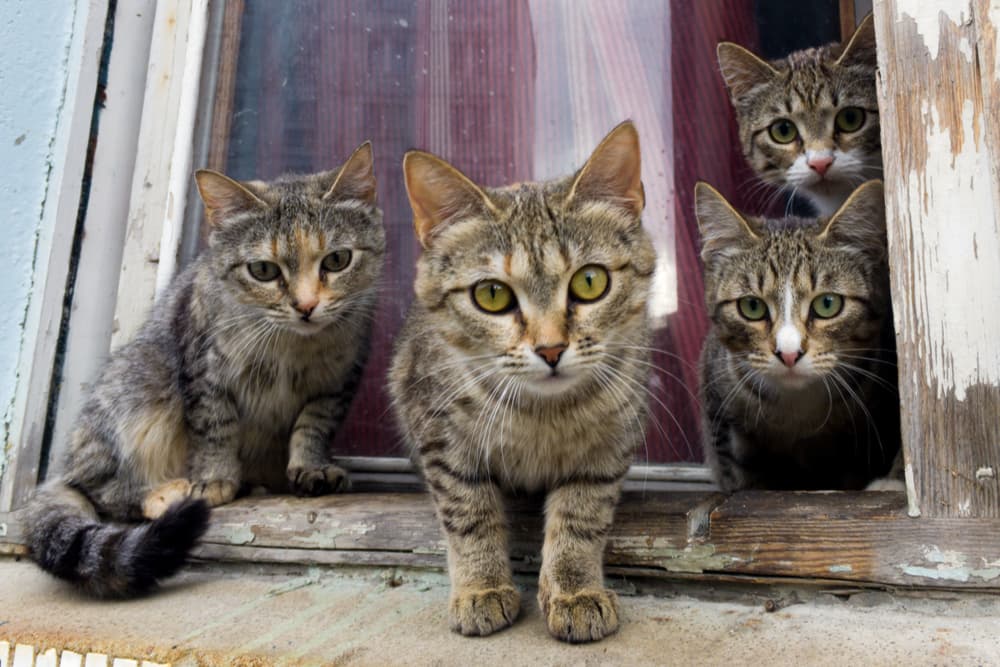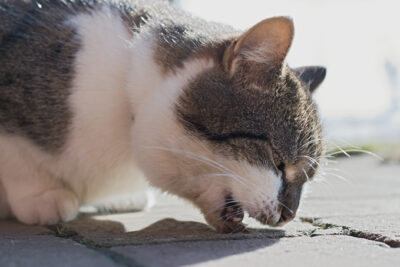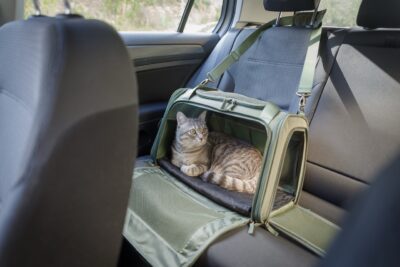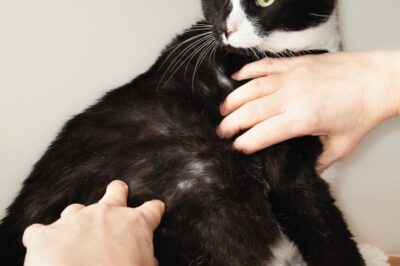All About Feline Leukemia Virus (FeLV)

Overview
- FeLV is a retrovirus that invades the organs of the immune system and can infect cells in the bone marrow.
- In the US, 3 percent of cats have FeLV, which is three times more common than diabetes mellitus.
- The FeLV virus is spread oronasally, meaning through the mouth and nose, and lowers the immune system.
- Recognizing signs of illness early on is crucial, so bring your cat to the vet if any abnormal symptoms occur.
- There are several ways to prevent FeLV, including spaying, vaccination and indoors-only lifestyle.
Sponsored by CareCredit
Feline Leukemia Virus (FeLV) is found worldwide in domestic cats. Its name is misleading—FeLV does not cause leukemia, which is a cancer of the blood cells. FeLV does however severely affect your cat’s immune system.
It shortens the lifespan of cats and can be spread between cats in a variety of situations, so it is crucial pet parents know about this condition. There is no cure, and many medical conditions may affect your cat because their immune system is decreased when infected with FeLV.
There are several ways to prevent this devastating disease. Let’s cover how FeLV impacts cats, the symptoms and treatment options, and what pet parents can do to help keep their cats safe from this virus.
What Is Feline Leukemia Virus?

FeLV is a retrovirus. This class of viruses inserts its genetic material, called RNA, into your cat’s own DNA. Once this occurs, your cat’s body will unknowingly create more FeLV through a natural process when it makes copies of its own DNA.
In cats, FeLV invades the organs of the immune system and, if it infects your cat for life, will infect cells in the bone marrow. The bone marrow is found in the center of some of the larger bones in the body and is responsible for making critically important cells—such as red blood cells and white blood cells, which prevent infection and are involved in inflammation. Once these cells are infected, FeLV is there to stay and affects the immune system lifelong.
How Common Is Feline Leukemia?
In the United States, approximately 3 percent of cats have this disease (1). This means that for every 100 cats tested, 3 cats will have the disease. In comparison, this is more than 3 times as common as diabetes mellitus in cats (2) and about as common as chronic kidney disease in adult (not senior) cats (3).
How Do Cats Get Feline Leukemia Virus?

The FeLV virus is spread oronasally, meaning through the mouth and nose. Any bodily fluid from an infected cat could spread FeLV—whether the fluid is saliva, sneezed droplets, eye discharge, urine, feces, or blood.
Sharing food bowls, grooming each other, and sharing a litter box can cause cats in a household to spread FeLV from one to another. FeLV can also be spread through deep bite wounds, which is uncommon in pets, but more prevalent in feral and stray cats.
The most common way for cats to be infected with FeLV is to contract it as a kitten from the mother cat. Kittens are infected with FeLV much more easily than adult cats. As cats get older, they build natural immunity to FeLV which reduces their risk of infection. Adult cats that are immunocompromised for any reason (i.e. high stress or another medical condition that lowers the immune system) will be more easily infected with FeLV.
Cats who live outdoors and/or are not spayed or neutered are more likely to contract FeLV. Outdoor cats are exposed to other cats of unknown health and are more likely to get into fights with other cats. Cats who are not spayed or neutered are more likely to fight with other cats and can suffer deep bite wounds that spread FeLV.
Can Kittens Be Born with Feline Leukemia?
Kittens can be born with the disease and contract it from their mother—called an in utero infection (before the kittens are even born). A mother cat can also transmit the disease to their kittens through sharing bodily fluids, such as from frequent grooming or through nursing (passing the virus in the milk).
How to Prevent Cats From Getting FeLV

There are several ways to prevent your cat from getting FeLV. Take the following steps to keep your cat safe.
Spay/neuter your cat. The most common way to spread FeLV is from mother cats to kittens. Cats who are not spayed or neutered are also more likely to fight, which can spread FeLV.
Allow an indoors-only lifestyle. This will help your cat avoid infections, trauma, and interacting with other unknown cats who may be infected.
Vaccinate your cat against FeLV. The FeLV vaccination may help, especially if your cat is at risk of exposure.
Test cats for the disease. This is especially important before introducing new cats into your household.
Keep your cat healthy. Preventative care such as core vaccinations, routine preventives (flea and parasite medications), and regular veterinary care will help keep your cat’s immune system as effective as possible.
The cost of these preventative measures can add up quickly. But they’re an important part of maintaining your cat’s overall health, as well as helping guard against FeLV. If you’re concerned about the expense, consider using a health and pet care credit card like CareCredit. Whether you use it for FeLV vaccinations or routine check-ups (at a provider in the CareCredit network), having a flexible way to pay can help ensure your cat gets the care they need without financial stress.*
FeLV Vaccine for Cats
Not every adult cat is recommended to receive the FeLV vaccination. But there are some circumstances where it is recommended for cats to be vaccinated. These include:
- If your cat goes outdoors.
- If your cat spends considerable time on porches or at screened windows and comes into close contact with roaming cats.
- If you decide to adopt or purchase a new cat that is either FeLV-infected or has not been tested.
- If you foster (temporarily care for) any cat whose status of FeLV infection is unknown.
Can Cats with Feline Leukemia Live with Other Cats?

Cats with FeLV can live with other cats, but prevention of spread of FeLV within the household is crucial.
Ideally, FeLV-infected and non-infected cats would not have direct contact, meaning they would not live in the same enclosed area. However, some pet parents wish to intermingle their cats and this could be done safely with the help of a veterinarian.
If a pet parent wishes to bring a FeLV-infected cat into a household with non-infected cats, the following guidelines are important to prevent the spread of the virus:
- Limited number (i.e. 1 or 2) of cats already in the household
- All non-infected cats are healthy adult cats with no known underlying medical conditions
- All non-infected cats are vaccinated not only with core vaccines (i.e. FVRCP and rabies) but also against FeLV with both boosters completed at least 3 weeks prior to introducing the FeLV-infected cat
- High level of enrichment and an abundance of all resources (i.e. food, water, litter boxes, toys, bedding, etc) for all cats to reduce stress.
These guidelines are meant to prevent stress in the home—not only to prevent fights between cats, but to support the immune system. Cats with chronic stress tend to have lowered immune systems and this is more common in multi-cat households.
Your veterinarian will make recommendations specific to your cat, depending on their risk.
Feline Leukemia Virus Symptoms

There are limited specific symptoms to FeLV, because FeLV generally lowers the immune system. This can result in any number of secondary conditions (medical issues not caused by the virus itself).
Initially after infection with FeLV, cats may experience a fever, mild lethargy (less active), and mild increase in the size of their lymph nodes. Most pet parents never even notice these subtle signs.
If a cat becomes infected lifelong, they will be more susceptible to other diseases, such as:
Gingivitis and stomatitis, or painful inflammation in the mouth. Symptoms include decreased appetite, vocalizing or pawing at the mouth during/after eating, blood-tinged saliva.
Feline Immunodeficiency Virus (FIV), another retrovirus in cats. Symptoms are rare. After initial infection cats may experience mild fever, lethargy, and increased size of lymph nodes.
Mycoplasma hemofelis, a blood bacterium that causes destruction of red blood cells (anemia) and comes from flea infestation. Symptoms include lethargy, decreased appetite, pale/white gums.
Lymphoma, a specific type of cancer that affects white blood cells of the immune system (can be found in the chest, abdomen, lymph nodes or skin). Symptoms are severe and vary depending on where the cancer is found. Symptoms could include severe diarrhea, chronic vomiting, lethargy, decreased appetite, weight loss, fast breathing, swelling of the lymph nodes and/or skin.
Neurologic disease. Symptoms may include ataxia (walking drunkenly), head tilted to one side, changes in behavior, decreased appetite, decreased activity, stumbling.
FeLV does have an end-stage. In progressive lifelong infections, cats may experience destruction of their red blood cells and white blood cells. This is untreatable and cannot be prevented. Symptoms include:
- Lethargy
- Decreased appetite
- Weight loss
- Pale or white gums
- Prolonged secondary infections (for example, upper respiratory infection that doesn’t go away).
Diagnosing Feline Leukemia Virus in Cats

FeLV is initially diagnosed with a simple blood test at your veterinary hospital. A very small amount of blood is taken and can either be sent to a laboratory or placed into a test at the hospital that gives a result within 10 minutes. This first test is looking for antigen, or a portion of the Feline Leukemia Virus itself.
If this test is positive, it is important to follow up with a second, more specialized test at the laboratory. This is because even though the antigen tests are reliable, treatment of certain medical conditions is known to be more challenging for FeLV-infected cats. It is crucial to confirm diagnosis.
There are two main laboratory tests to confirm diagnosis. Both can be used for confirmation of FeLV:
Polymerase chain reaction (PCR). This test looks for a specific form of the virus (provirus) found in all cats infected with FeLV.
Indirect immunofluorescence assay (IFA). IFA looks for white blood cells traveling in the blood that are infected with FeLV.
How to Treat Feline Leukemia Virus

Unfortunately, there is no cure for FeLV. However, infected cats can develop many different medical conditions that are treatable. Just because your FeLV-infected cat is sick does not mean they cannot be treated!
Your veterinarian is key to determining what is causing your cat to be ill. For any cat with FeLV, recognizing signs of illness early on is crucial. Bring your cat to the veterinarian immediately if any abnormal symptoms occur including subtle changes in behavior, appetite, or activity.
Antiretroviral therapies (chemotherapy) are frequently used in humans with other types of retrovirus infection. However, minimal research has been done on these medications to determine if they are effective against FeLV in cats. Also, these medications can have serious side effects for our feline friends.
Medications for Feline Leukemia Virus in Cats
One of the only antiretroviral therapies that is shown to be effective against FeLV is zidovudine (also known as azidothymidine). This medication will not cure FeLV, but it will decrease the amount of virus and improve some disease states related to FeLV, such as stomatitis. Zidovudine can be injected or given by mouth.
Interferons are injectable medications meant to improve the immune system, including feline interferon omega. However, there are not many well designed studies that demonstrate if this medication truly improves the outcome of cats with FeLV. In a study with only 16 cats that were infected with FeLV or FIV, secondary infections over a short period improved with this medication (4). More studies are needed before it can be determined if these interferons help cats with FeLV.
General Cost to Treat Feline Leukemia

Initial testing in cats for FeLV as well as veterinary examination will typically cost $100-$200. Other secondary medical conditions that may occur and are not caused by FeLV vary in treatment from $100 to treat an upper respiratory infection to thousands of dollars to treat stomatitis.
Ongoing care for FeLV-positive cats can involve regular vet visits and treatments, which can get costly. Pet insurance may help offset the cost of care, but it depends on your plan and type of coverage. Another option that can give you peace of mind is a CareCredit credit card, which provides flexible financing options for veterinary services, making it easier to budget for your cat’s health and wellness.*
Since there is no treatment for end-stage FeLV, there is no true cost other than possibly palliative care (keeping your cat comfortable until time for euthanasia).
Life Expectancy of Cats with Feline Leukemia
In scientific studies, cats tend to live two to three years after diagnosis of FeLV. However, the age at which cats are diagnosed with FeLV is highly variable. In one study, the median age was 2 years old and the cats lived an average of 2.5 years (5). In essence, the average cat infected with FeLV lived to be approximately 5 years old.
Many cats are diagnosed with FeLV when they show symptoms of illness that prompts testing. Knowing this, it is possible for a cat infected with FeLV to live a normal lifespan—not every cat infected with FeLV will show unusual symptoms of illness.
Cats with FeLV live longer if pet parents bring them to the veterinarian to treat secondary medical conditions that can occur. The diagnosis of FeLV infection is NOT a reason to euthanize your cat. Many cats with FeLV will respond to treatment for different conditions and live a good quality of life, perhaps for many years to come.
Related Conditions
- Gingivitis
- Stomatitis
- Feline Immunodeficiency Virus (FIV)
- Mycoplasma hemofelis
- Lymphoma
- Neurologic disease
*Subject to credit approval. See carecredit.com for details.
This information is shared solely for your convenience. Neither Synchrony nor any of its affiliates, including CareCredit, make any representations or warranties regarding the products described, and no endorsement is implied. You are urged to consult with your individual veterinarian with respect to any professional advice presented.









